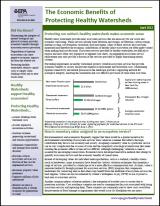Benefits of Healthy Watersheds
Why identify and protect healthy watersheds? In many ways, healthy watersheds substantially affect the quality of life for people and the environment overall – often by performing ‘free work’ that communities do not have to do, or pay for, themselves. The beneficial roles of watersheds in healthy condition can be surprisingly far-reaching and include ecosystem services, economic benefits and physical and mental health benefits.
On this page:
Ecosystem Benefits and Services

Healthy watersheds provide many ecosystem services including, but not limited to: nutrient cycling, carbon storage, erosion/sedimentation control, increased biodiversity, soil formation, wildlife movement corridors, water storage, water filtration, flood control, food, timber and recreation, as well as reduced vulnerability to invasive species, the effects of climate change and other natural disasters. These goods and services are essential to our social, environmental and economic well-being.
The wide array of critical ecosystem services provided by healthy watersheds is frequently undervalued when making land use decisions. Due to the complexity of natural systems and economic precedents, it is difficult to assign a dollar amount to a particular ecosystem service. However, there is a large body of research and evidence to support the fact that intact healthy ecosystems avoid costly restoration and ecosystem service replacement, and provide long-term economic opportunities and jobs. Some healthy watershed ecosystem services include:
- Improved water quality. Natural landscapes and floodplains filter pollutants from point and nonpoint sources, promote nutrient cycling, and help retain sediment.
- Carbon storage opportunities. Watersheds with intact natural land cover and soil resources are capable of sequestering carbon, thereby offsetting greenhouse gas emissions (Hanson et al., 2010).
- Increased resilience in the face of climate change threats. Intact floodplains and riparian areas enable healthy watersheds to be better adapted to more extreme weather patterns and changes in precipitation associated with climate change.
- Reduced risk for invasive species colonization. Naturally functioning ecosystems are more resilient and can favor indigenous species, helping them out-compete invasive species.
Economic Benefits

Protecting healthy watersheds can reduce capital costs for water treatment plants and reduce damages to property and infrastructure due to flooding, thereby avoiding future costs. Additionally, protecting healthy watersheds an generate revenue through property value premiums, recreation and tourism:
- Reduced drinking water treatment and infrastructure costs. Natural landscapes filter pollutants and protect water quality. A review of treatment costs and watershed characteristics for 27 drinking water utilities found that for every 10% increase in forest cover of the source water area, chemical and treatment costs decrease by 20% (Ernst, 2004). In a separate case, New York City found it significantly more cost-effective to protect the watershed’s natural land cover and forests to provide natural filtration, rather than installing a multi-billion dollar water treatment facility (Barnes et al., 2009).
- Reduced flood mitigation costs. Floodplains and natural landscapes minimize the area and impacts of floods, reduce the burden on public drainage infrastructure and increase groundwater recharge (Postel and Richter, 2003).
- Increased revenues and job opportunities. Healthy watersheds provide ample opportunities for fishing, boating, swimming, hiking, biking, wildlife viewing and ecotourism. Over 30 million people in the U.S. fish recreationally and these anglers generate approximately 1 million jobs and over $45 billion in retail sales annually (Southwick Associates, 2008). Overall, the outdoor recreation industry contributes $646 billion annually to the economy, supports 6.1 million jobs, and generates $79.6 billion in federal and state tax revenues (Outdoor Industry Association, 2003).
- Increased property values. Housing near healthy watersheds has higher property values than those in or around degraded ecosystems and impaired waters (Maine DEP, 2005).
Learn more on the factsheet "The Economic Benefits of Protecting Healthy Watersheds" (PDF).
Physical and Mental Health Benefits
-

- Decreased stress and Improved cognitive development. Students have been shown to have lower stress levels and reduced levels of attention deficit disorder when they are exposed to green spaces (Wells, 2000).
- Higher likelihood to exercise. People are more likely to exercise if they have easy access to recreation areas like parks, trails, greenways, and forests. People who exercise regularly are generally healthier, have fewer insurance claims and spend less time in hospitals, thus their societal health care costs are lower (US NPS, 1995).
